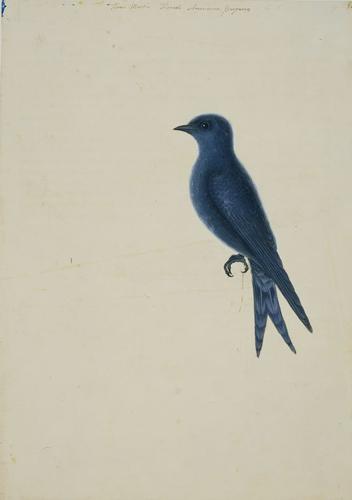-
1 of 253523 objects
The Purple Martin c.1722-6
Watercolour and bodycolour with gum arabic over pen and ink | 38.1 x 26.9 cm (sheet of paper) | RCIN 925884
-
A watercolour of a purple martin (Progne subis (Linnaeus)). The drawing shows a small deep blue/purple bird, perched, profile left. Inscribed in pen and ink: (top centre) 'Hous Martin Hirundo Americana Purpurea', and (top right) 51. Inscribed in pen and ink on verso: 'Martin'.
The paper bears half of a watermark of a shield with a fleur-de-lys (Type A in Henrietta McBurney, Illuminating Natural History. The Art and Science of Mark Catesby, New Haven and London, 2021, p. 225-6).
Mark Catesby was born in Suffolk and was interested in natural history from an early age. In 1712, he travelled to the east coast of America with his sister Elizabeth, who had married a doctor who practised in Williamsburg, Virginia. Catesby spent seven years in Virginia collecting specimens and seeds for London buyers before returning to Britain. In London his drawings of birds and plants met with praise and a group of benefactors paid for his travel to Carolina in 1722. There, he made numerous drawings of the flora and fauna, working hard to ensure that his depictions were as helpful for an understanding of their subjects as possible. On his return to Britain, his drawings were reproduced in The Natural History of Carolina, Florida and the Bahama Islands, which appeared in a series of volumes between 1729 and 1747. The first volume was dedicated to Queen Caroline, the second to Augusta, Princess of Wales. The original drawings from the volumes, which had been in the possession of Catesby’s widow until her death, were purchased by George III from the London bookseller Thomas Cadell in 1768.
The watercolour was used as the basis for plate 51 in the first volume of the Natural History. In the accompanying text, Catesby noted that these martins 'breed like Pigeons in lockers prepared for them against houses, and in gourds hung on poles for them to build in, they being of great use about houses and yards, for pursuing and chasing away Crows, Hawks, and other vermin from the Poultry. They retire at the approach of Winter, and return in the Spring to Virginia and Carolina.'
For identification of the species depicted see James L. Reveal, 'Identification of the plants and animals illustrated by Mark Catesby for his Natural History of Carolina, Florida, and the Bahama Islands' in Phytoneuron 2013 and revised online version.Provenance
Thomas Cadell; from whom bought by George III, 1768
-
Creator(s)
Acquirer(s)
-
Medium and techniques
Watercolour and bodycolour with gum arabic over pen and ink
Measurements
38.1 x 26.9 cm (sheet of paper)
Other number(s)
RL 25884Alternative title(s)
Hirundo Purpurea
